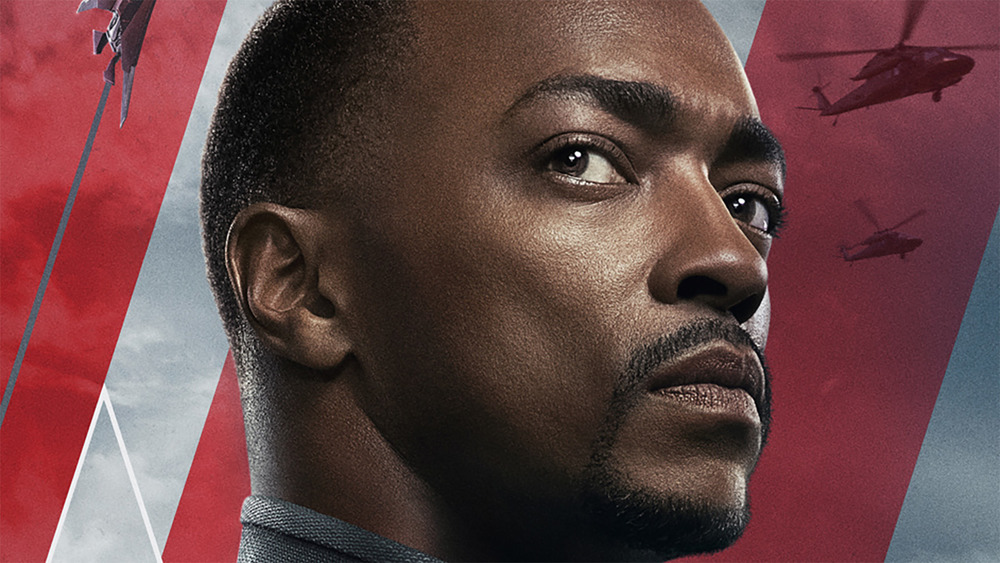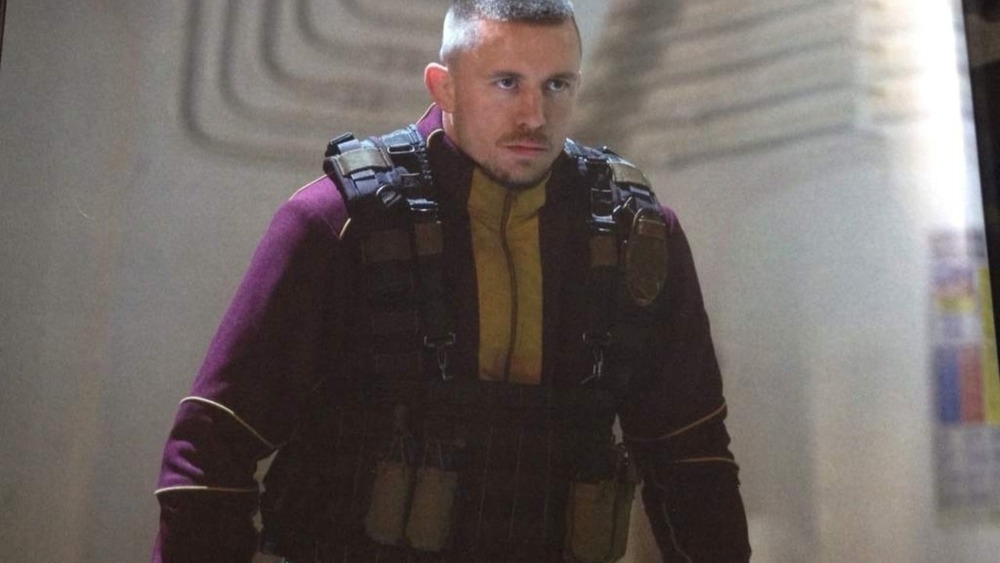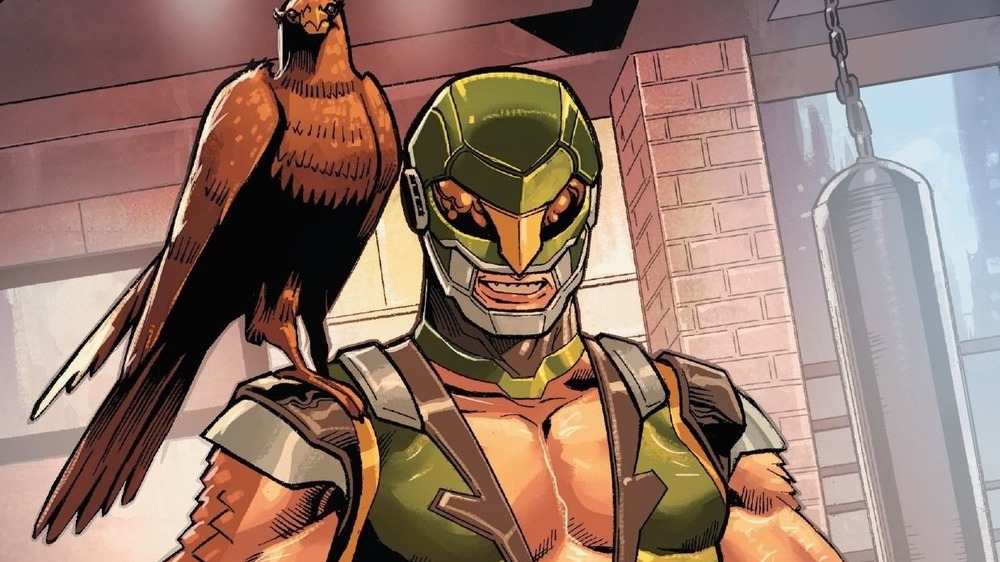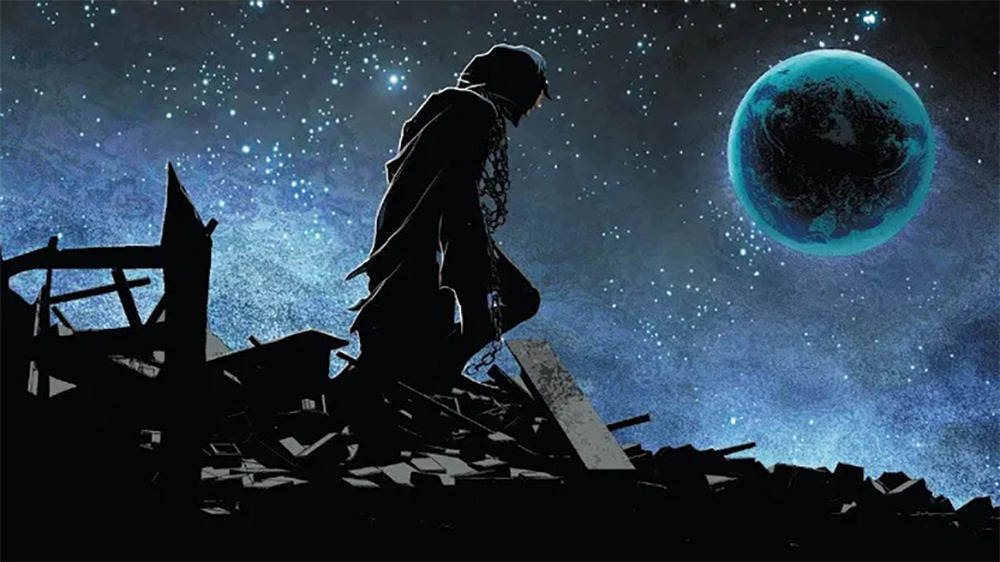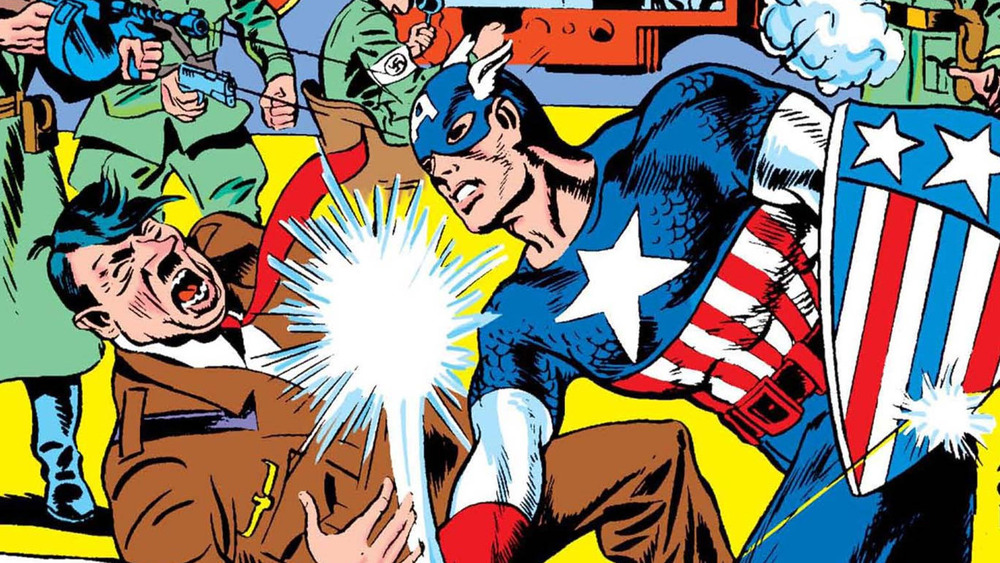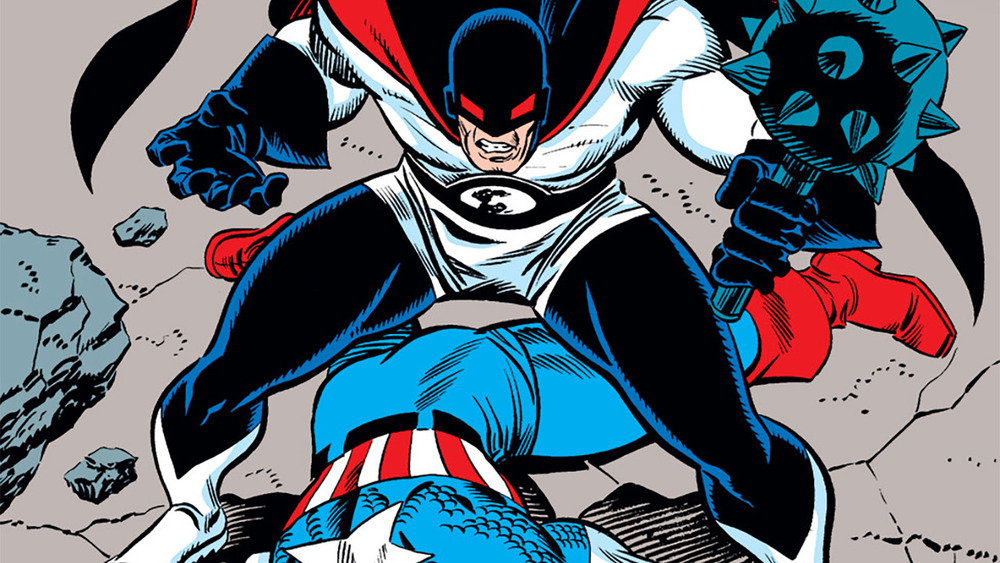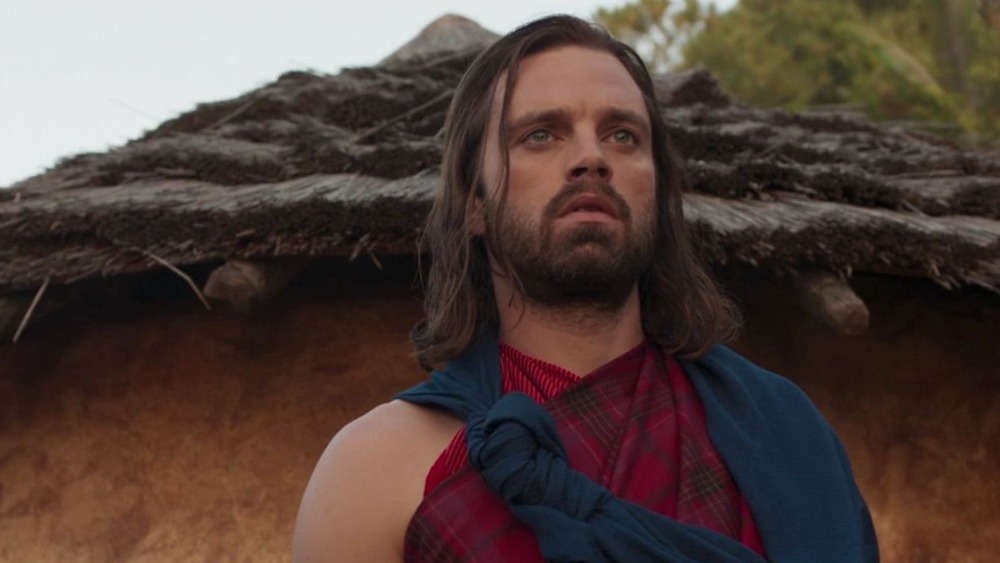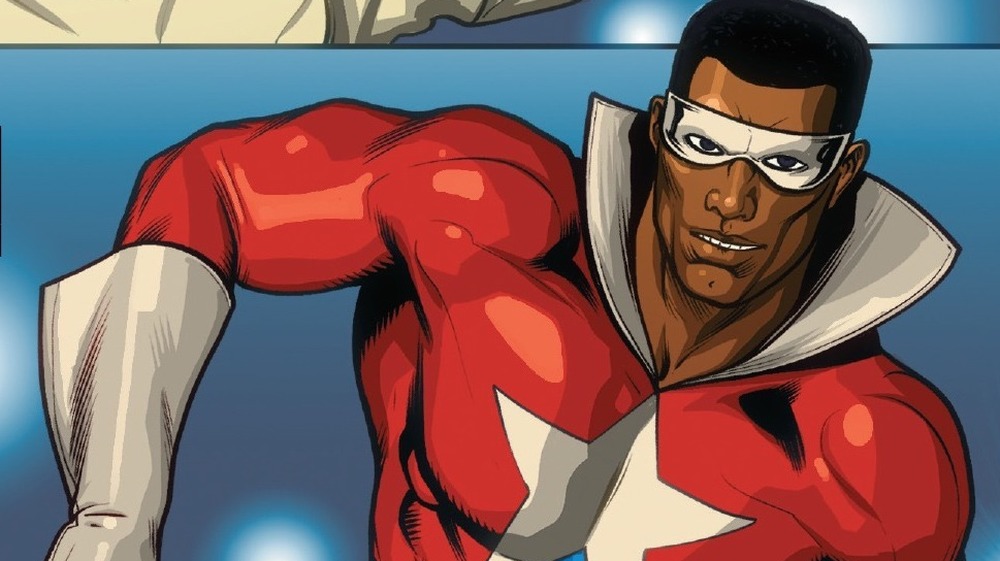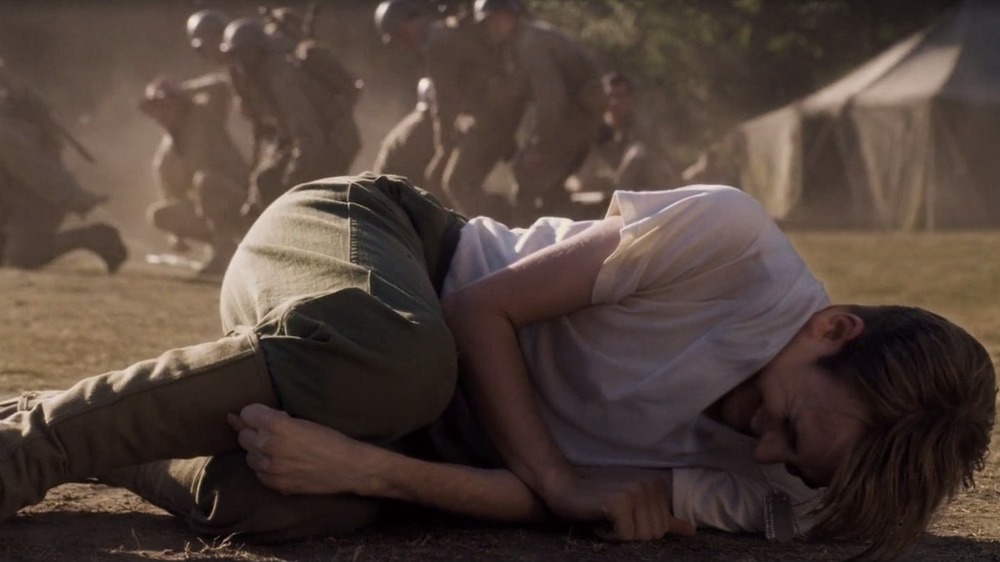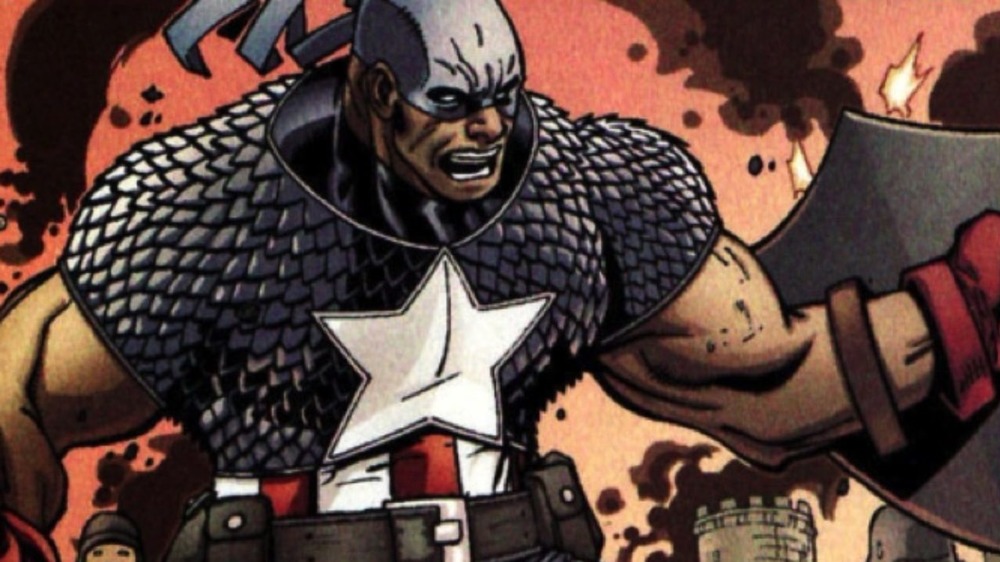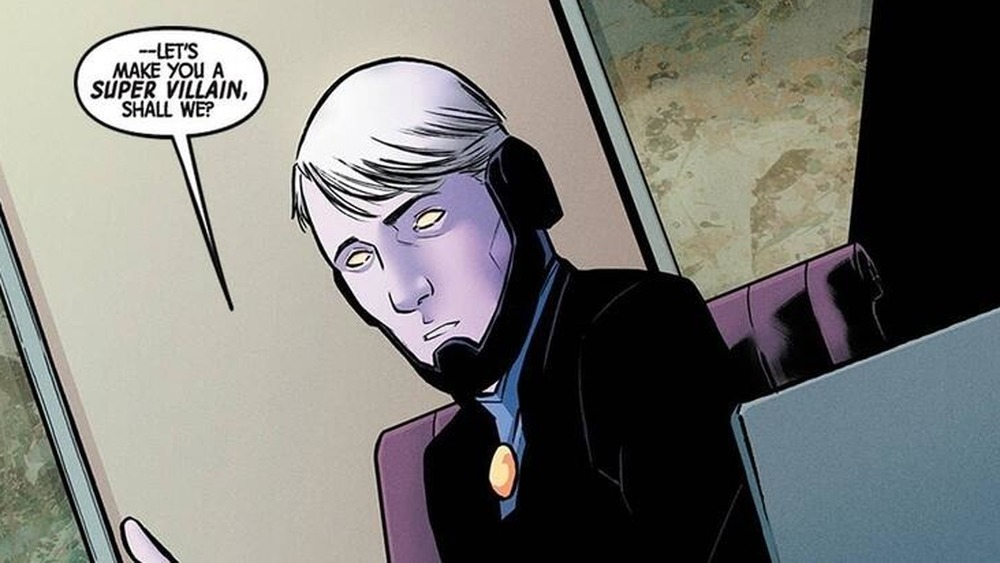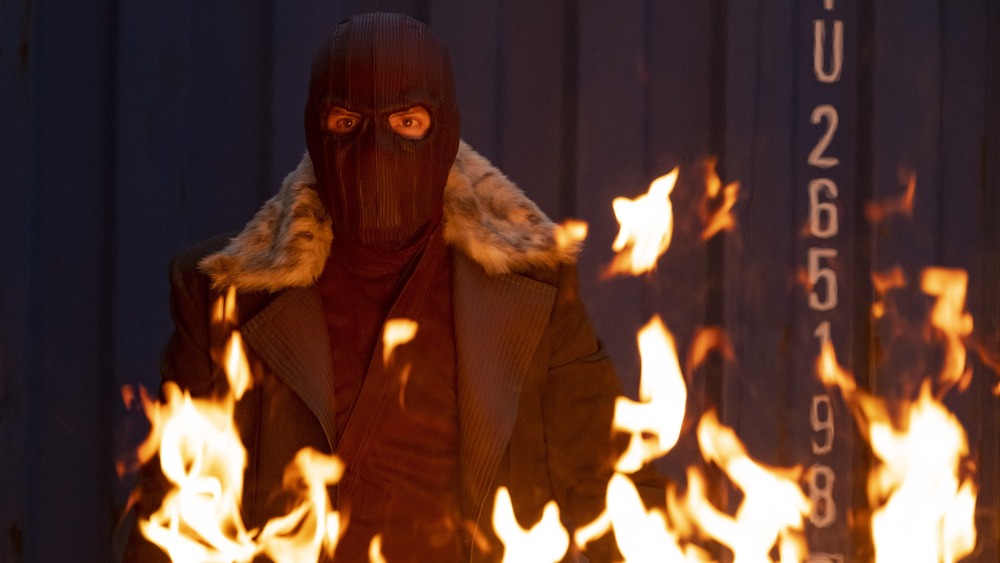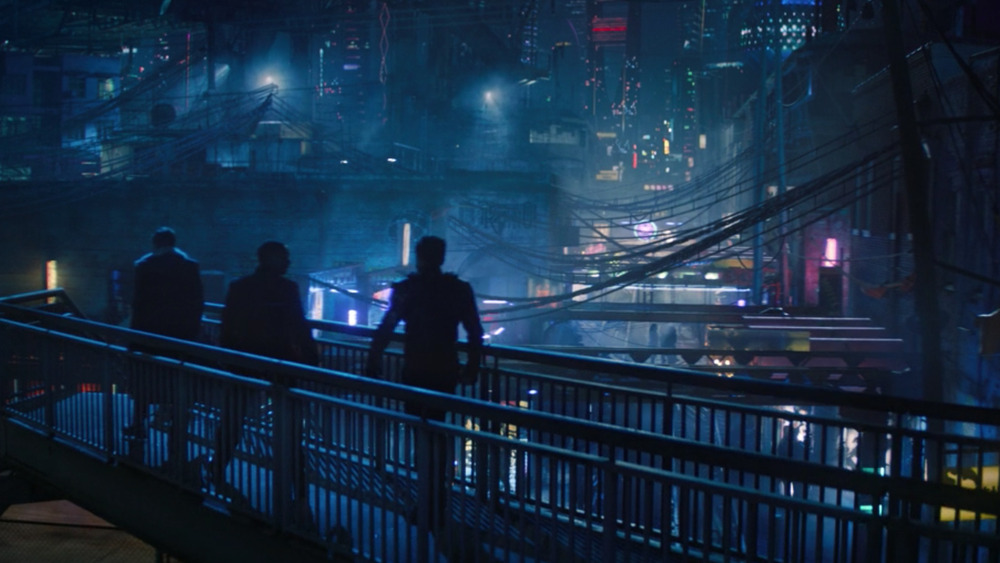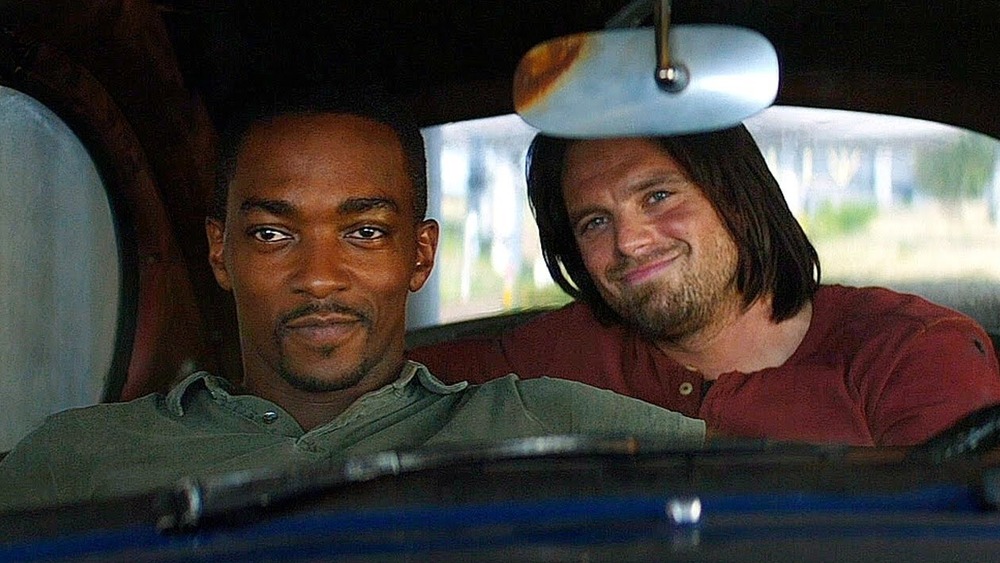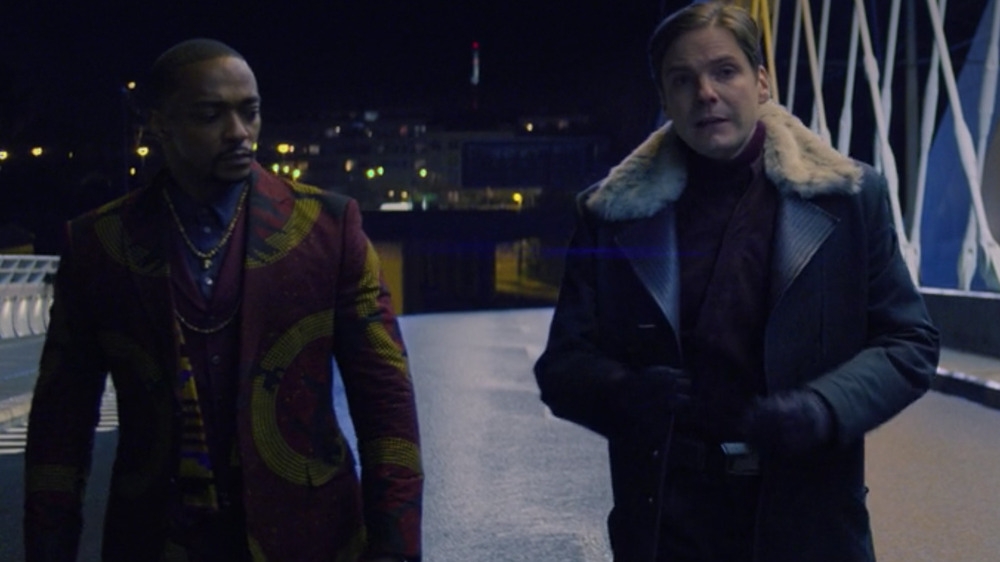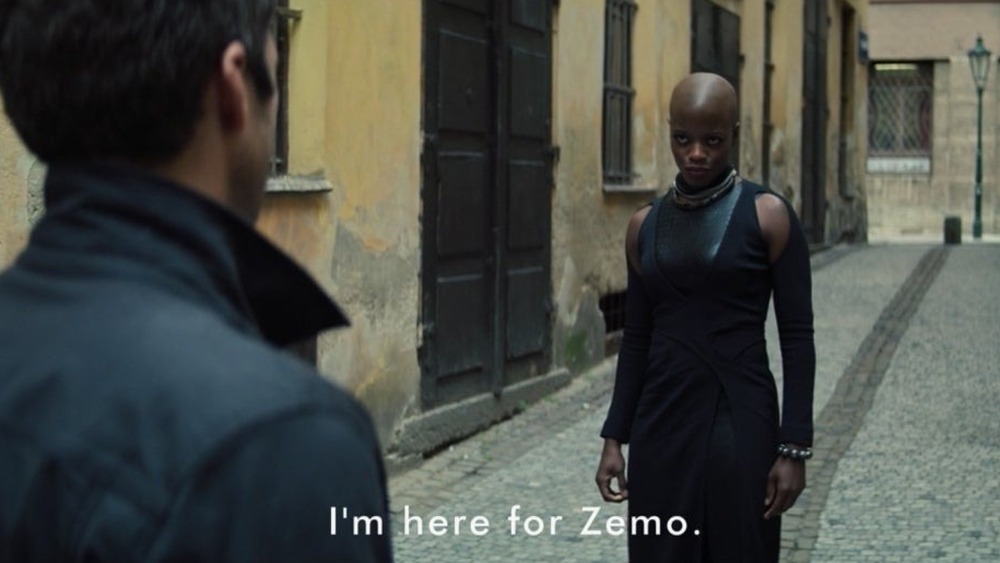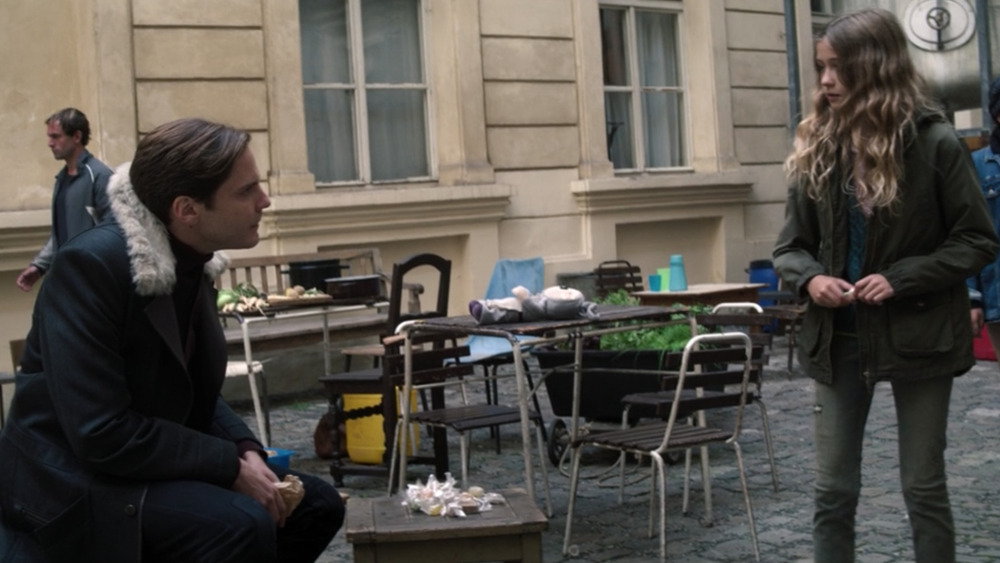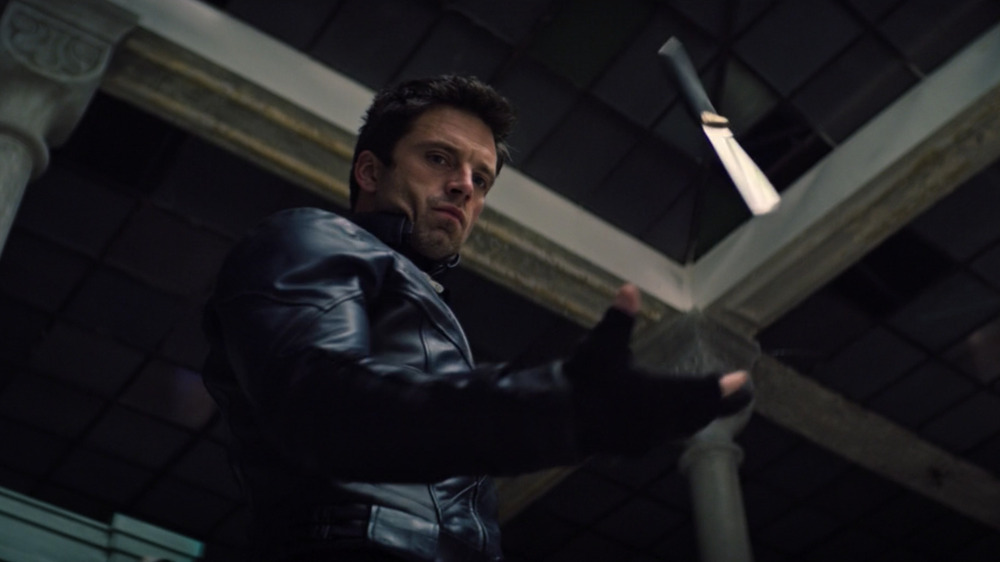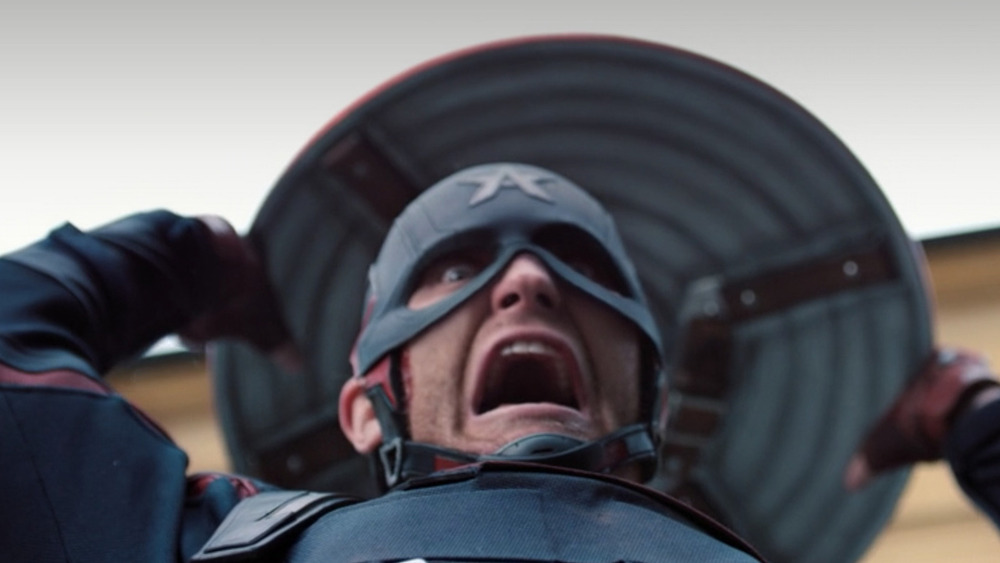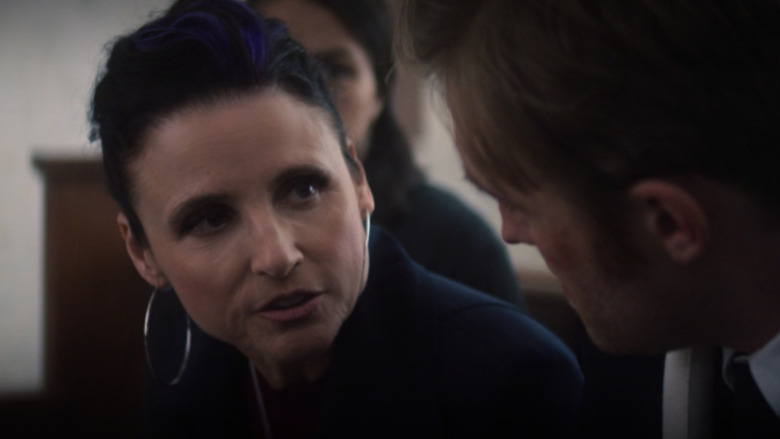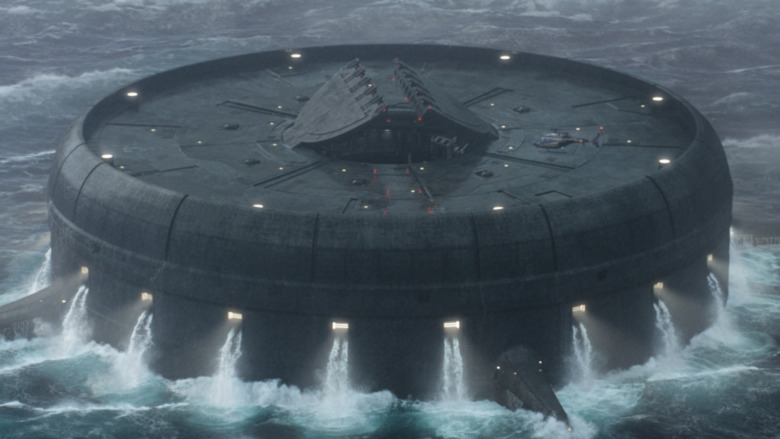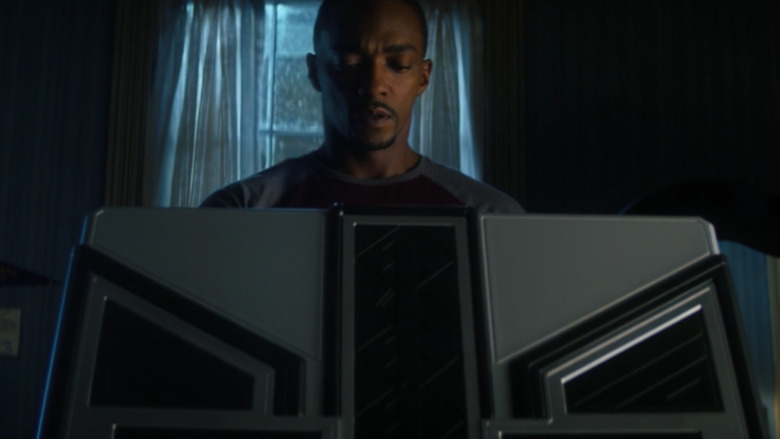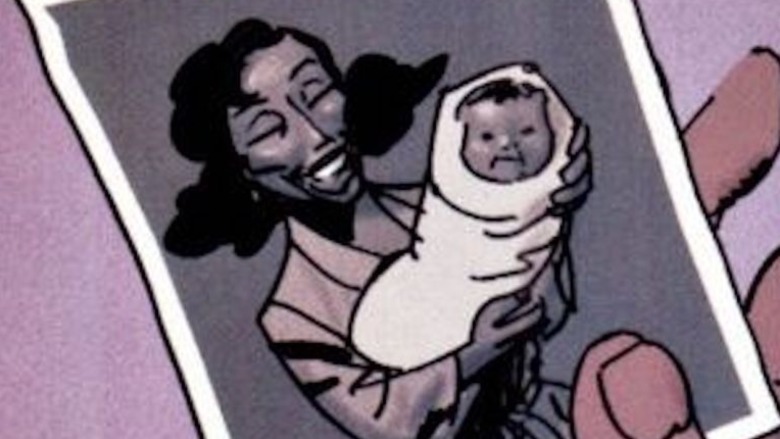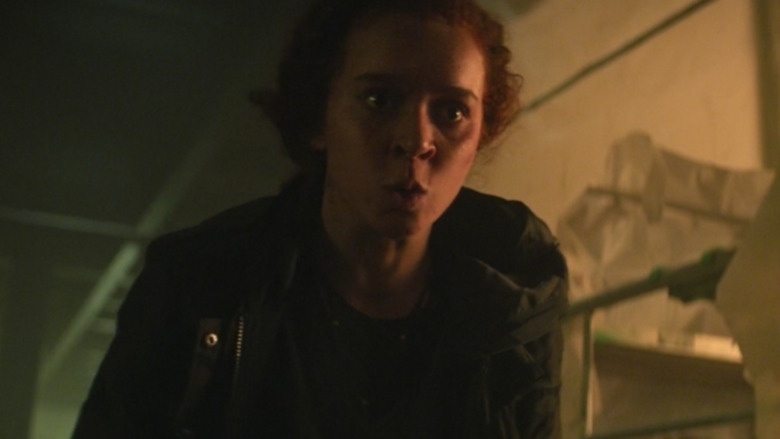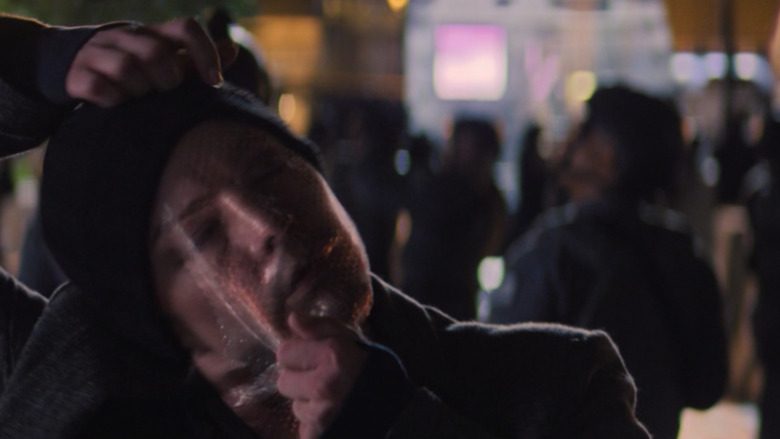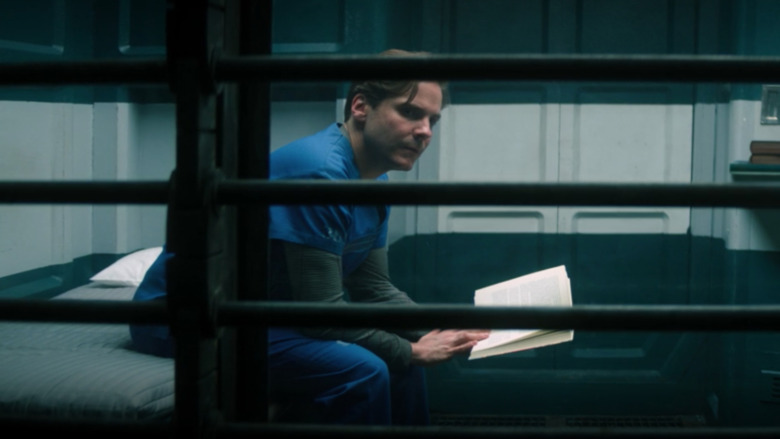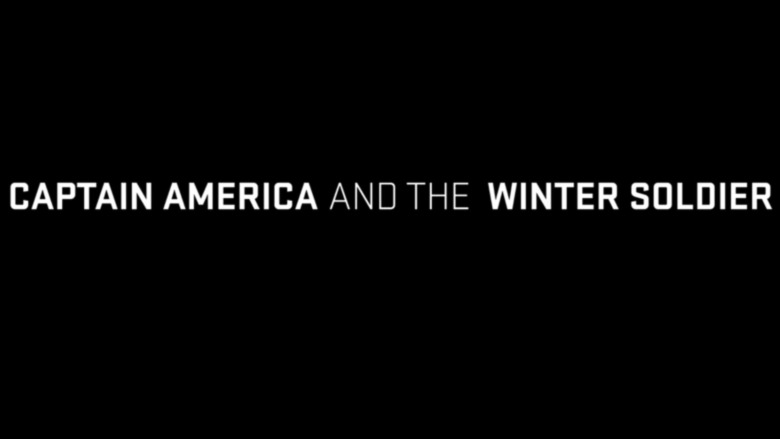Easter Eggs You Missed In The Falcon And The Winter Soldier
The Marvel Cinematic Universe is a pretty busy place. "Avengers: Endgame" changed the landscape forever, "Spider-Man: Far From Home" provided a solid epilogue, and "WandaVision" offers a few tantalizing hints about what the future holds. And then there's "The Falcon and the Winter Soldier," which hurls itself forward at breakneck speed into an MCU of entirely new heroes, villains, and crises.
"The Falcon and the Winter Soldier" is full of everything that makes Marvel so special. Like the movies, this Disney+ series has pulse-pounding action scenes, loveable characters played by some of the most charismatic actors in the business, and a heaping pile of Easter eggs. From references to past movies to homages to the comic books that inspired the MCU to teases of stories yet to come, "The Falcon and the Winter Soldier" is bursting with small details for die-hard Marvelites to pore over. Here are a few you might've missed.
Batroc the Leaper returns
"The Falcon and the Winter Soldier" opens with a stunning action set piece featuring the Falcon performing a daring rescue. If the leader of the airborne kidnappers looks familiar to you, there's a very good reason: That's none other than Georges Batroc, the dangerous mercenary who Steve Rogers fights in the opening scenes of "Captain America: The Winter Soldier." He is played in both the film and "The Falcon and the Winter Soldier" by MMA legend Georges St-Pierre.
In "Winter Soldier," Captain America runs up against Batroc while rescuing hostages aboard the Lemurian Star, which Batroc has hijacked. Of course, comic readers know Batroc better as Batroc the Leaper, a kickboxing master who's been a thorn in Captain America's side since his debut in 1966's "Tales of Suspense" #75. While Batroc is sometimes depicted as a formidable foe, the comics often use him as a source of comic relief, thanks to his goofy name, flamboyant costume, and ridiculously dramatic moustache.
Putting Sam Wilson up against a classic Captain America baddie, thus showing that the Falcon is just as capable as Steve Rogers when it comes to taking on supervillain threats, is a canny way for "The Falcon and the Winter Soldier" to set the stage early. He may not believe it yet, but Sam Wilson is absolutely Steve's equal. Just ask Batroc.
A new Falcon takes flight
In "The Falcon and the Winter Soldier," Bucky Barnes isn't Sam Wilson's only partner-in-crime-fighting. As he tracks down those who would do the country harm, the Falcon also teams up with a young American GI named Joaquín Torres. In "New World Order," Torres provides Sam with operational support while he's tussling with Batroc's forces. He later infiltrates a Flag Smasher rally in order to figure out what the terrorist organization is up to.
Joaquín's connection to the Falcon goes much deeper than mere friendship, though. Torres made his comics debut in 2015's "Captain America: Sam Wilson" #1. He emerges during a period in which Sam Wilson has taken over Steve Rogers' superhero identity. As a Mexican-American living in Arizona, Torres is concerned about the well-being of the immigrant community. Unfortunately, Joaquín's good intentions attract the attention of the Sons of the Serpent, a racist terrorist group that capture him and ship him off to Dr. Karl Malus for experimentation.
Malus uses the DNA from Wilson's avian partner Redwing (in the comics, Redwing is an actual bird and not a drone) to mutate Torres, giving him wings and the same psychic link with Redwing that Wilson enjoys. Eventually, Wilson rescues Torres, but the mutations are permanent. Thus, Torres takes on the mantle of the Falcon, and becomes the new Captain America's faithful sidekick.
Who watches the Watcher?
"Online, there's been a lot of stuff about Steve. Crazy, crazy conspiracy theories," Torres confides in Sam, during a rare moment of downtime. "Some people, they think that he's in a secret base on the Moon, looking down over us." Sam shoots the idea down, but really, it's not as silly as it sounds. In the comics, all sorts of characters live on the Moon.
Most notably, the Moon is home to the Inhumans, a genetically-enhanced off-shoot of the human race. Technically, the Inhumans are already part of MCU: They're the subject of 2017's short-lived "Inhumans" series, which received poor reviews and was canceled very quickly. Uatu the Watcher, a mysterious alien being who observes human history but is forbidden from interfering, also lives on Earth's biggest satellite.
Most likely, however, Torres' line is a sly reference to none other than Nick Fury. In the comics, Fury spends a few years on the Moon, where he takes over Uatu's responsibilities. In the line-wide crossover known as "Original Sin," Fury kills Uatu and steals one of his eyes in order to solve an outer-space mystery. As punishment, the rest of the Watchers imprison Fury on the Moon, dub him the Unseen, and force him to watch over Earth, helpless to assist, as further catastrophes unfold. Thankfully for Fury, his punishment doesn't last: Uatu eventually returns from the dead, and relieves Fury of his duties.
A quick journey through Captain America's history
Chris Evans' Steve Rogers isn't in "The Falcon and the Winter Soldier," but his legacy looms large over the entire series. After donating Steve's shield to the Smithsonian Institution (before that same shield is handed to John Walker, creating a new, government-controlled superhero), Sam Wilson and James Rhodes (Don Cheadle) take a walk through the museum's Captain America exhibit.
The fictional exhibit is dominated by Steve's World War II exploits. The motorcycle and the prop shield he used during USO shows, as seen in "Captain America: The First Avenger," figure prominently, as does his original WWII combat uniform. Look a little closer, and you'll also see a picture of the 4F classification that originally kept Steve Rogers from enlisting, a photo of Steve receiving the Super-Soldier serum, and a shot of Steve holding the door of a taxi cab, among other doo-dads and mementos.
The most important artifact, however, is "Captain America Comics" #1. This item is much bigger than the MCU, of course — it exists in our world as well. This 1941 comic, written by Joe Simon and drawn by Jack Kirby, contains Captain America and Bucky's debut. Its cover, which depicts Cap punching Hitler in the jaw, was considered particularly bold at the time: The comic came out a year before America officially entered the war, and its overtly political message inspired so much public anger, Simon and Kirby were assigned police protection.
The smasher behind the mask
While long-time Captain America nemesis Baron Zemo is "The Falcon and the Winter Soldier's" best-known bad guy, the first episode of the series introduces an entirely different threat: The Flag Smashers. The Flag Smashers are a group of terrorists who fight for "a world without borders" and believe that life in the MCU was better before the Blip.
As you've probably guessed, the Flag Smashers' origin comes from the comics — although the original Flag-Smasher is a single man, not an organization. Created by revered Captain America writer and long-time Marvel Comics editor Mark Gruenwald and prolific inker and Marvel UK editor Paul Neary, Karl Morgenthau is a skilled martial artist who dreams of being a diplomat. When Karl's father is killed, however, the young activist decides that violence is the only way to achieve peace. He thus adopts the moniker Flag-Smasher and begins a one-man terror operation. Needless to say, that's pretty different from the take offered by "The Falcon and the Winter Soldier."
The White Wolf returns
Just before Bucky Barnes and Sam attempt to jump the Flag Smashers, the two have one of many hilarious exchanges in an abandoned warehouse. Bucky's stealthy behavior prompts Sam to call him the White Panther as a joke, referencing the time Bucky spent in Wakanda after the events of "Captain America: Civil War." Bucky quickly corrects him, saying, "It's actually White Wolf." This confuses Sam for a moment, but the scene moves on without further discussion.
We first see Bucky referred to as the White Wolf in the second post-credits scene from "Black Panther." Some village children refer to Bucky by this name while he is residing in Wakanda under the watch of Shuri (Letitia Wright) and T'Challa (Chadwick Boseman). T'Challa later calls Bucky this name during "Avengers: Infinity War," before giving him a new vibranium arm for the impending battle against Thanos' army. "The Falcon and the Winter Soldier" marks the first time we've heard Bucky refer to himself as the White Wolf.
In the comics, the Winter Soldier and the White Wolf aren't actually related. According to Marvel, the White Wolf is Hunter, T'Challa's adopted white brother. King T'Chaka takes Hunter in as an infant after he crash-lands in Wakanda with his parents, who don't make it out of the wreckage alive. He eventually becomes the leader of the Wakandan secret police, and takes on the White Wolf moniker.
First a new Cap, now a new Bucky?
While John Walker, the new Captain America, is practicing for his first big interview, he's greeted by a friend who gives him a pep talk. Later, this man officially introduces himself as Lemar Hoskins to Sam and Bucky after the tractor trailer highway battle, and even reveals his hero name, Battlestar.
First appearing in 1986's "Captain America" #323, Hoskins was a wrestler until he was granted superhuman abilities by the Power Broker. His bond with John Walker is strong: The two are picked by the government to be the new Cap and Bucky. This explains why our Bucky gets angry at the mention of Battlestar and hops out of the car when he and Sam talk to the pair after the highway battle.
In the comics, Hoskins joins a group called the Bold Urban Commandos, AKA the Buckies (yes, really). The Buckies and Walker — known at this time as Super-Patriot — battle Steve Rogers and lose. Some time after this, the government taps Walker to become the new Captain America, and Hoskins the new Bucky. The latter eventually dubs himself Battlestar. In 1989's "Captain America" #350, Steve regains the mantle of Captain America, prompting Battlestar to retire to his hometown of Chicago.
Ever jump on a grenade?
As an angry Sam and Bucky walk away from their highway battle defeat in "The Star-Spangled Man," Walker and Hoskins ride up on them. Bucky tells Walker that holding the shield doesn't mean he's Captain America, and asks if Walker has ever jumped on top of a grenade. Walker says he has four times, but he uses his helmet to protect himself, unlike our friend Steve Rogers (Chris Evans) does in "Captain America: The First Avenger."
Don't recall that moment? Here's a refresher. While training in boot camp, Colonel Chester Phillips (Tommy Lee Jones) tosses a dead grenade at a group of his recruits to see how'll they respond. Without hesitation, Rogers, still weak and skinny at this point, dives on top of the grenade to absorb the explosion and protect those around him. It's one of the character's most memorable and moving heroic deeds, and Bucky's subtle invocation of it speaks volumes.
One of the ones HYDRA feared the most
We meet Isaiah Bradley (Carl Lumbly) in "The Star-Spangled Man," after Bucky and Sam fail in their fight against the Flag Smashers. In a brief conversation, we learn that Bucky and Isaiah have battled one another in the past, and that the latter was actually able to rip off half of Bucky's arm. Bucky mentions that there are "more of you and me" out there, and we proceed to discover that Isaiah is another super soldier with a heartbreaking past.
First appearing in 2003's "Truth: Red, White & Black" #1, Isaiah is sometimes known as the Black Captain America. In that comic, he and 299 other Black soldiers are experimented on as part of governmental efforts to replicate the Super-Soldier serum. Though Isaiah shows enormous bravery during World War II, he is court-martialed and imprisoned for 17 brutal years. In "The Falcon and the Winter Soldier," Isaiah reveals he was in jail for 30 years, during which time constant tests were performed upon him.
Bucky lets Sam know that Isaiah is a hero, and as feared by HYDRA as Steve Rogers was. Sam is understandably angry to learn that the world — including himself, a fellow Black hero — doesn't know about Isaiah. Steve experiences similar dismay in "Truth: Red, White & Black" when he learns of Isaiah's life and hidden heroism.
The Power Broker giveth, and the Power Broker taketh away
Founded by Curtiss Jackson, Power Broker is both an organization and a man, first appearing in 1978's "Machine Man" #7. Jackson aims to profit from making super soldiers, despite the extreme riskiness of the process.
In the comics, the Power Broker transforms both John Walker and Lemar Hoskins into super soldiers, though this isn't the case in "The Falcon and the Winter Soldier." The Power Broker is, however, responsible for the Flag Smashers' superhuman abilities. But he's not happy with them: One of the group's members mentions "the Power Broker's men" are the ones coming after them during the private plane escape scene. Will the MCU introduce Curtiss Jackson in the future? Only time will tell. Monikers are fluid in this universe — multiple people can take on a single title, and sinister organizations (cough, HYDRA) can live for years, carried on by a variety of faces in a whole lot of different places.
Zemo's backstory is revealed
In "Power Broker," we finally get to see Zemo (Daniel Bruhl), whose return has been looming since the series' beginning. Knowing that the villain is the only way to help track down the origin of the new Super-Soldier serum, Bucky helps him break out of a high-security prison with ease. After getting kinda-sorta approval from Sam, the three men are treated to a private plane ride across the globe.
It turns out that Zemo is rich — really rich — and there's a reason why. Finally, we hear this classic Marvel villain note that he is a baron, a title that's always been associated with Zemo in the comics, but never yet uttered in the MCU, until now. Zemo was a member of the Sokovian aristocracy, but that was all taken from him when Ultron decimated the country.
In the comics, the Zemos are actually of German descent. There have been 13 barons in total, with Helmut (Bruhl) being the most recent. In 1973's "Captain America" #168, Helmut becomes disfigured by Adhesive X, a dangerous weapon created by his father, Heinrich Zemo, and dons a mask to cover the damage. There's no instance of Adhesive X or any kind of face injury to Zemo in "The Falcon and the Winter Soldier," so his mask-wearing is likely an homage to the character and his father.
An island rich in Marvel history
Most Marvel Comics fans are well aware of Madripoor, a Southeast Asian island. While a lot of exciting stories have gone down here, Madripoor is most closely associated with something we've yet to see in the MCU: mutants. Namely, Wolverine.
Madripoor is first mentioned in 1985's "New Mutants" #32. Wolverine spends a decent amount of time here, going by the name of Patch. Even beyond Wolverine, though, the X-Men's connections to Madripoor are endless. Mystique attempts to set up an X-Men haven there in 2015's "All-New X-Men" #37. Magneto uses the island as a temporary holding zone for time-displaced mutants in 2017's "X-Men Blue" #1. With Madripoor now canon in the MCU, we can expect several visits to the island moving forward — possibly led by mutant characters.
"Power Broker" also contains subtle nods to Madripoor's Lowtown, including brief shots of local businesses made famous in the comics. The Princess Bar and the Brass Monkey Saloon (AKA The Bronze Monkey), where Sam, Zemo, and Bucky meet Selby (Imelda Corcoran), are iconic Lowtown hotspots. In the comics, the Princess Bar is owned by a man named O'Donnell, and offers entertainment to residents of both Hightown and Lowtown. But O'Donnell doesn't run the show on his own: He has help from his silent partner, Wolverine. Given Wolverine's stature in Marvel canon, this is an homage that shouldn't be taken lightly.
You gonna move your seat up?
"The Falcon and the Winter Soldier" does a fabulous job of referencing famous and fan-favorite scenes from prior MCU projects. In "The Star-Spangled Man," for example, we see Bucky recall the time Steve Rogers threw himself on a grenade he thought was live in boot camp. In "Power Broker," we get a more playful throwback to a scene from "Captain America: Civil War," in which Sam refuses to move his seat up for Bucky while they wait for Steve to talk to Sharon Carter (Emily VanCamp).
After the trio, along with Sharon, meet Doctor Wilfred Nagel in the shipping containers and all hell breaks loose, they jump into a swanky convertible which Zemo has been hiding. Sam takes the back seat, which offers little leg room, and a callback to the beloved moment follows: "You gonna move your seat up?" As in "Civil War," Bucky replies with a deadpan "no," and away the men go, one less comfortable than the other.
Bad nickname, bad dude
Just before diving into Lowtown, Sam is given a very brief history of the man he is supposed to be impersonating: Conrad Mack, AKA the Smiling Tiger. Luckily, Sam resembles Conrad, whom he notes has a "bad nickname." First appearing in 1992's "New Warriors" #19, Conrad is the son of a Vietnam veteran and a cult member who deals in magic.
Conrad is also affiliated with the Thunderbolts, a team of reformed criminals led by Helmut Zemo himself. Other heroes in the group include Goliath, Moonstone, Beetle, Fixer, and Screaming Mimi. Smiling Tiger doesn't have an extensive history in the comics, and we likely won't see much more of him moving forward in the MCU. But his mention does open the door for the Thunderbolts, also occasionally known as the Masters of Evil, who have a long and fascinating history. The group has further ties to the Winter Soldier and Black Widow, who have both led the team during different moments in its history.
Move, or you will be moved
In "Power Broker's" final moments, we get a shocking cameo from Ayo (Florence Kasumba), a member of the Wakandan Dora Milaje. We first meet Ayo in "Captain America: Civil War," when she tells Natasha Romanoff (Scarlett Johansson) to move so T'Challa (Chadwick Boseman) can enter his car. If Natasha refuses to comply, Ayo makes it clear that she "will be moved" by force. She reappears in "Black Panther" and "Avengers: Infinity War," serving under General Okoye.
Ayo is here for one purpose, and one purpose only: To collect Helmut Zemo, the man responsible for the death of King T'Chaka (John Kani). Many unanswered questions linger: Namely, how the meeting between Bucky and Ayo came to be, and how the latter knows Zemo is out of prison and ready for the taking. Nevertheless, Ayo's appearance officially ties Wakanda into the events of "The Falcon and the Winter Soldier."
Zemo's Turkish delight is an homage to another universe
In the first act of "The Whole World is Watching," Sam, Bucky, and Zemo try to get information on Donya Madani, Karli's deceased adoptive mother. It's a dead-end for Sam and Bucky, as the duo seem to scare off everyone they come in contact with. Sam does manage to have one brief conversation with a refugee, but he refuses to give up any information on Donya.
Then we see Zemo outside, approaching a group of children while singing "Baa Baa Black Sheep." He dumps a pile of candy in front of them — the same Turkish delight he mentioned to Bucky and Sam, inside the Latvian apartment. He tells the group of kids that the candy was his son's favorite. Zemo uses the sweets as a way to dazzle the youngsters and get information out of them. It works like a charm: The little girl reveals when and where Donya's funeral will be.
While this seems like the sort of simple, clever tactic you might see on an episode of "Law & Order," Zemo's use of the candy actually has a connection to another fictional universe. Turkish delight is the candy the White Witch uses in "The Chronicles of Narnia" to get information out of Edmund Pevensie. It's Edmund's favorite candy, but the White Witch's sweets are also enchanted, making them impossible to resist.
The Winter Soldier's knife skills return
Trailers for "The Falcon and the Winter Soldier" contained a tantalizing clip of Bucky showing off his impressive knife skills. In "The Whole World is Watching," we finally get to see the super soldier in all his blade-wielding glory. During the high-octane fight with the Flag Smashers at their home base, Bucky shows off his skills, notably his ability to throw and catch a knife by its handle like it's no big deal.
This specific instance of him tossing his knife in the air and catching it before throwing it down next to a Flag Smasher's head is also a nod to a famous fight scene from "Captain America: The Winter Soldier": Bucky is replicating a move he used on Steve Rogers during the street fight scene in the 2014 movie. In "The Whole World is Watching," Bucky's knife does a couple more spins than it does in the film, and looks different because of the vantage point. Both scenes, however, show off just how slick Bucky's skills are.
This display of skill is yet another instance of the series referencing the MCU's most memorable moments. It should also be noted that this moment shows Bucky's growth as a character, as he is not willing to kill, which is why he throws the knife by his opponent's head. The Winter Soldier, in contrast, has no problem with ending a life.
A shield-smashing throwback
In "The Whole World is Watching," Walker kills a Flag Smasher by driving his shield into his chest. This gives us one of the series' most eerie shots: John Walker seen from below, as he holds a bloody shield. This specifically invokes a prior moment in Steve Rogers' history, making it all the more clear how dramatically the old Cap differs from the new Cap.
In the final battle of "Captain America: Civil War," Steve uses his shield to smash Iron Man's (Robert Downey Jr.) helmet. Instead of landing a blow to the head, as the audience expects, Cap digs his shield into Tony's arc reactor, which puts his suit out of commission. Steve easily could have killed or seriously injured Tony in that moment, but that's not who he is. He uses his shield as a way to subdue his opponent, instead of killing him.
"The Falcon and the Winter Soldier" employs cinematography reminiscent of what's used in that "Civil War" scene, making for a unique and potent Easter egg. Walker doesn't have a personal history with this Flag Smasher, as Steve does with Tony, but he also doesn't have the ability to stop himself and assess the situation, which makes him highly dangerous. There's a darkness inside of Walker, which has been emphasized by the Super-Soldier serum running through his veins. Steve doesn't have that darkness in him, making him a much better Captain America on all fronts.
Contessa Valentina Allegra de Fontaine, Val for short
"Truth" definitely delivers on the surprise cameo front. While Walker is talking to his wife Olivia (Gabrielle Byndloss) in the courthouse after being stripped of his Captain America title, a mysterious woman approaches the duo, played by Julia Louis-Dreyfus. She forces herself between husband and wife and begins to talk to Walker while ignoring Olivia's presence altogether. She is Contessa Valentina Allegra de Fontaine, but she tells Walker to just call her Val. She then suggests that he just doesn't call her anything, cementing the sentiment by giving him a blank business card.
Val has a rich history in the comics, beginning with her first appearance in 1967's "Strange Tales" #159. She is particularly known for her very close relationship with Nick Fury, whom she meets while training as a SHIELD agent: Val wins Fury over by defeating him in hand-to-hand combat. She moves up through the ranks, eventually becoming a leader at SHIELD. That doesn't appear to be her motive in "The Falcon and the Winter Solider," however.
Once a sleeper agent for the covert Soviet organization known as Leviathan, Val has always had connections to Russia. She even joins HYDRA at one point for Leviathan's sake, claiming the ominous mantle of Madame Hydra for herself. Her status as a Russian agent becomes known, however, and she was last seen in prison.
The Raft is back
We first see the Raft in "Captain America: Civil War": General Thaddeus Ross (William Hurt) imprisons some of our favorite heroes there for going "rogue." In the comics, however, the Raft is generally known for housing supervillains.
Ayo mentions to Bucky that she'll be taking Zemo to the Raft, and we don't suspect he'll lay low upon arrival. If Zemo's comics history is any indication, he might assemble the Thunderbolts while at the Raft. First appearing in 1996's "Incredible Hulk" #449, the villainous group is originally assembled by Zemo and disguises itself as a superhero team. Thought the Raft serves as home base for the Thunderbolts for some time, the group has since been stationed all over the world.
Over the years, more than a handful of famous figures have joined the Thunderbolts. The founding members consist of Goliath, Moonstone, Beetle, Fixer, and Screaming Mimi, though they change their names to Atlas, Meteorite, Mach-I, Techno, and Songbird, respectively. Whether or not these will be Zemo's prospective recruits remains to be seen. It was rumored that Erin Kellyman would be playing Songbird before the series started, but that was debunked when she was revealed to be Karli Morgenthau. The future is unwritten, however — who knows who Zemo might meet behind bars?
A gift from Wakanda
Before Ayo takes Zemo to the Raft, Bucky asks her for one last favor. He brings a very Wakandan-looking briefcase with him to New Orleans, and, by the end of the episode, we're still not privy to what's inside. We do find out in the series finale, though: Sam's been gifted some new gear, straight from Wakanda.
Such a gift has a long history in the comics. Black Panther has designed a set of wings for Falcon at two points: First in 1974's "Captain America" #170, and later in 2004's "Captain America and the Falcon" #6. The first wings are detachable and fit with mini solar panels. The second set of wings are much fancier, being made of "hard light" — basically, they're holographic. Their wingspan can reach 50 feet and take on a multitude of shapes and sizes, allowing Sam to customize the suit as needed on the fly. Coming from Wakanda, the harness is also fit with vibranium, which can protect Sam from gunfire. They're controlled mentally through a new helmet, which also offers infrared vision, advanced magnification, and other such abilities. Sam is definitely at his peak with the hard light wings on, just as the wings he gets in "The Falcon and the Winter Soldier" take him to the peak of performance.
You gotta have Faith
When Sam revisits Isaiah in Baltimore, the latter man briefly mentions his wife. She died while he was in prison, and believed Isaiah to be dead. This story is slightly different from the one told in the comics: There, Isaiah's wife, Faith Shabazz, is instrumental in getting him out of prison. First appearing in 2003's "Truth: Red, White & Black" #1, Faith marries Isaiah in 1940. Isaiah joins the Army shortly afterward, in the wake of the Pearl Harbor attacks. The two conceive a child before he leaves, and Faith gives birth to their daughter, Sarah Gail, while he is away. After Faith begs the government to pardon Isaiah for years, Isaiah is finally released and sworn to secrecy about his life's events.
Faith is also a grandmother to Eli Bradley, Sarah's son, who currently resides with the MCU's Isaiah in Baltimore. Eli, sometimes known as Patriot, is a founding member of the Young Avengers, having gained superhuman strength through a blood transfusion from his grandfather. Faith is still around in the comics, and has occasionally worked as a professor of comparative religion.
Stay down
When Karli knocks Sam down after the Flag Smashers infiltrate the GRC building, she tells him to "stay down." It's clear Karli doesn't want to hurt Sam, and is giving him an out. After a brief moment of hesitation, Sam stands back up and replies with a simple "no." Sharp-eared fans might have expected him to follow that up with Steve Rogers' classic line, "I can do this all day," but he does not.
Echoing Steve so directly would have been a little too much fanfare — especially when "stay down" is a classic MCU line in and of itself. Karli and Sam's fight is reminiscent of Steve and Tony Stark's in "Captain America: Civil War." In that movie, while Bucky is down, Steve and Tony go head to head. When the former gets knocked down, Tony tells him, "Stay down. Final warning." In true Captain America fashion, Steve rises, saying, "I can do this all day."
By creating this new scene with Karli and Sam, the writers give a call back to a great MCU moment, while also giving Sam a chance to shine as his own version of Captain America. Repeating one of Steve's most famous lines wouldn't carry as much weight as Sam's simple refusal: He's formed his own identity under the same mantle.
Trading faces
In the beginning of "One World, One People," we learn that Sharon has traveled back to the United States when she shows up at the GRC to aid Bucky and Sam against the Flag Smashers. She approaches Bucky as a strange man who asks if he's in the right place, and is soon revealed to be Sharon in a very expensive face mask. This kind of tech would make Ethan Hunt jealous, and is also a major callback to "Captain America: The Winter Soldier."
We first see this face-swapping tech in that "Captain America" sequel, when Black Widow (Scarlett Johansson) impersonates Councilwoman Hawley of the World Security Council. Hawley is in support of Project Insight, an initiative shut down by Steve Rogers and company, thanks in part to Natasha impersonating the Councilwoman.
Sharon's mask is nearly identical to the one Natasha uses. This is a little shocking, given that it implies the tech hasn't progressed in nine years. But hey, with a nearly perfect mask like that already in existence, maybe there isn't much to improve upon.
Zemo's light reading
In "Power Broker," Bucky asks Zemo what book he's reading in his cell just before he breaks out of prison. Zemo tells him it's Machiavelli, which most viewers will assume means he's reading "The Prince." But the book Zemo is reading is actually "Fortuna ist ein Reissender Fluss" by Roger D. Masters, which the English-speaking world knows as "Fortune is a River: Leonardo da Vinci and Niccolo Machiavelli's Magnificent Dream to Change the Course of Florentine History." Zemo is reading the same book in "One World, One People" in his Raft prison cell, apparently still focused on absorbing all the Machiavelli he can.
While this book wasn't penned by Machiavelli himself, Zemo's mention of the famous diplomat hints at his inspirations and ambitions. Machiavelli famously believed in good ends justifying rulers' brutal means, and approached politics as a necessarily dirty business. "Fortune is a River" explores Machiavelli and da Vinci's hopes of making Florence a seaport, per "Publishers Weekly," a project Machiavelli approached with far less noble intent than da Vinci. It's an interesting choice for Zemo, who likely won't stay in that prison cell for long.
A new title
If you weren't paying attention to the final title card for "The Falcon and the Winter Soldier," you might have missed a crucial detail. As the letters slowly appear on the screen, the card is revealed to read "Captain America and the Winter Soldier," solidifying Sam's new mantle.
While this does confirm Sam's new role in the MCU, it could also be a hint about the show moving forward with a second season, perhaps under a different name. Season 2 has not been confirmed at this time, but executive producer Nate Moore has given fans hope by saying the end of the first season could offer hints as to what stories might now be told "in a subsequent season."
Some fans on Twitter were a little upset that the end title card didn't read "Captain America and the White Wolf," since Bucky's Wakandan nickname is mentioned multiple times during the series. It doesn't look like this is the end for Bucky, though — he might very well enjoy a transformation of his own in the future. Here's hoping.
